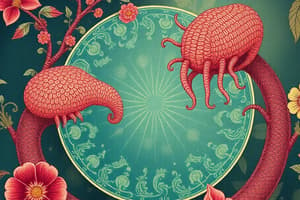Podcast
Questions and Answers
What type of reproduction involves the formation of two individuals due to a small growth breaking off from a parent organism?
What type of reproduction involves the formation of two individuals due to a small growth breaking off from a parent organism?
- Budding (correct)
- Parthenogenesis
- Fission
- Fragmentation
Which mode of reproduction involves unfertilized eggs developing into viable offspring without male involvement?
Which mode of reproduction involves unfertilized eggs developing into viable offspring without male involvement?
- Parthenogenesis (correct)
- Fission
- Budding
- Fragmentation
What type of reproduction allows organisms to produce offspring without the involvement of another individual's genetic material?
What type of reproduction allows organisms to produce offspring without the involvement of another individual's genetic material?
- Budding
- Sexual reproduction
- Fission
- Asexual reproduction (correct)
Which process occurs after fertilization and leads to the formation of the gastrula with the future digestive cavity?
Which process occurs after fertilization and leads to the formation of the gastrula with the future digestive cavity?
What is formed after a zygote undergoes cell division and develops into a 6-32-celled hollow structure?
What is formed after a zygote undergoes cell division and develops into a 6-32-celled hollow structure?
Which type of reproduction leads to genetically diverse offspring but requires both males and females for successful reproduction?
Which type of reproduction leads to genetically diverse offspring but requires both males and females for successful reproduction?
What is the result of the successful union of haploid gametes in sexual reproduction?
What is the result of the successful union of haploid gametes in sexual reproduction?
Which organisms are mentioned as capable of sexual reproduction in the text?
Which organisms are mentioned as capable of sexual reproduction in the text?
What is a key characteristic of asexual reproduction?
What is a key characteristic of asexual reproduction?
Which developmental stages are determined by Hox genes in most animals?
Which developmental stages are determined by Hox genes in most animals?
What is formed when an external fertilization process occurs in sexual reproduction?
What is formed when an external fertilization process occurs in sexual reproduction?
Which type of organisms exhibit asexual reproduction alongside a sexual phase in their life cycle?
Which type of organisms exhibit asexual reproduction alongside a sexual phase in their life cycle?
Flashcards are hidden until you start studying
Study Notes
Organismal Biology: Understanding Reproduction and Developmental Stages
Organismal biology encompasses various aspects of life cycles, reproduction, and development of organisms. Here, we take a closer look at sexual reproduction, asexual reproduction, developmental stages, and reproductive organs.
Understanding Sexual Reproduction
Sexual reproduction involves the combination of haploid gametes from both male and female individuals of a species. The gametes typically consist of a small, motile sperm cell and a larger, sessile egg cell. Upon successful union of the gametes, a diploid fertilized egg, called a zygote, is formed. Some species are also capable of sexual reproduction, producing offspring via external fertilization or through internal fertilization followed by laying or giving birth to the offspring.
Insects, Reptiles, Fish, and Amphibians: Organisms Capable of Sexual Reproduction
Most animals undergo sexual reproduction and follow similar patterns of development determined by Hox genes. However, some exceptions exist, such as cnidarians, flatworms, and roundworms, which exhibit asexual reproduction alongside a sexual phase in their life cycle. Insects like grasshoppers undergo incomplete metamorphosis, where they display features such as different head-tail directionality, the number and placement of appendages, and animal head-tail directionality - blastula: a 6-32-celled hollow structure that is formed after a zygote undergoes cell division.
Exploring Asexual Reproduction
Asexual reproduction allows organisms to produce offspring without the involvement of another individual's genetic material. This type of reproduction includes processes like fission, budding, fragmentation, and parthenogenesis.
- Fission involves an organism splitting itself into two halves, sometimes even regenerating missing parts in each new organism. Planarian worms and some other aquatic animals use this method to reproduce.
- Budding sees a small growth on the surface of a parent organism breaking off, resulting in the formation of two individuals. Yeast and some animals like the hydra are known to employ this technique.
- Fragmentation occurs when an organism breaks into two or more fragments that develop into a new individual. This process is often used by corals, sponges, and starfish, among others.
- Parthenogenesis involves unfertilized eggs developing into viable offspring without male involvement. Certain insects follow this mode of reproduction, such as those exhibiting "haplodiploidy," which produces male offspring from unfertilized eggs.
Advantages and Challenges of Sexual vs. Asexual Reproduction
Sexual reproduction leads to genetically diverse offspring, which can enhance species adaptability. However, it requires the presence of both males and females for successful reproduction and comes with higher resource costs due to the need for gamete production. On the other hand, asexual reproduction allows rapid population expansion but may lead to lower genetic variation and potential incorporation of deleterious mutations over time.
Hosting and Nurturing Developing Embryos
After fertilization, an embryo undergoes various stages of development, with the zygote leading to the formation of a blastula. The blastula then undergoes gastrulation, a process that leads to the formation of the gastrula, where the future digestive cavity is formed. Different cell layers (called germ layers) are formed during gastrulation, which are preprogrammed to develop into certain tissue types, organs, and organ systems during organogenesis. The series of developmental stages for the embryo remains largely consistent across most animal species, regardless of whether they undergo complete or incomplete metamorphosis.
In summary, understanding organismal biology involves comprehending processes like sexual reproduction, asexual reproduction, and developmental stages. These aspects provide insight into how various life forms reproduce and grow from a zygote to maturity.
Studying That Suits You
Use AI to generate personalized quizzes and flashcards to suit your learning preferences.




